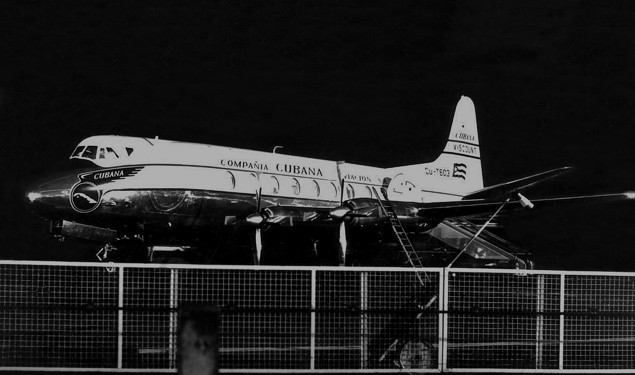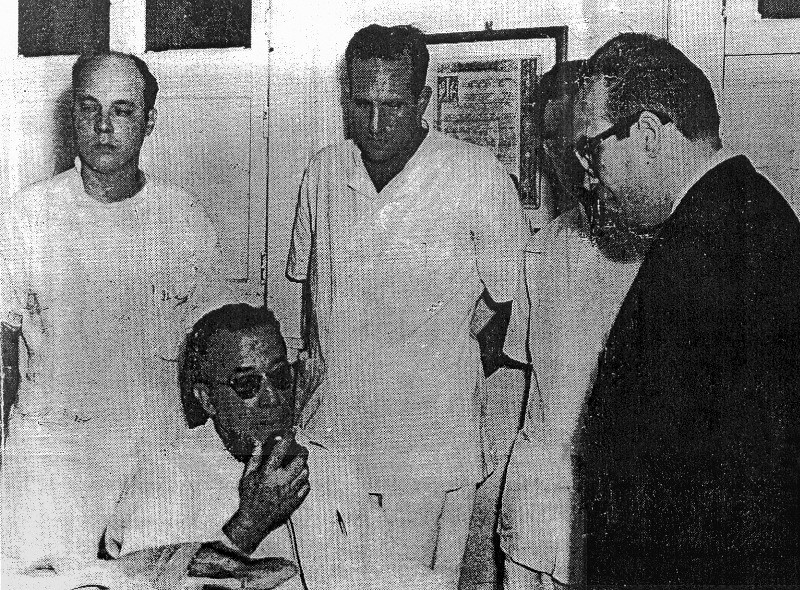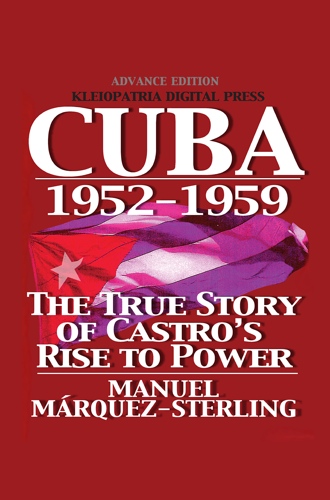November 3, 1958
 (L to R) Rodolfo Laucirica; Jose Hernandez Cata; Uva Hernandez Cata de Márquez-Sterling; Carlos Márquez-Sterling; Patricio Estevez; Osvaldo Ruiz Aguilera. Nov 3, 1958
(L to R) Rodolfo Laucirica; Jose Hernandez Cata; Uva Hernandez Cata de Márquez-Sterling; Carlos Márquez-Sterling; Patricio Estevez; Osvaldo Ruiz Aguilera. Nov 3, 1958On 3 Nov 1958 the most critical elections in Cuban history were held. The three major presidential candidates were: Carlos Márquez-Sterling for the Partido del Pueblo Libre; Ramón Grau San Martín for his faction of the Partido Revolucionario Cubano, Auténtico; and Andrés Rivero Agüero for a coalition of government parties. There was also a minor party candidate on the ballot, Alberto Salas Amaro for the Union Cubana party.
Campaign rallies of Batista's opponents were frequently sabotaged not by the Batista government, but by Castro and the revolutionaries. Under constant death threats by Castro forces the electoralist candidates were unable to visit many parts of the country. Their only practical recourse was effective use of radio, television and the printed word. As Time contemporaneously reported:
Where Batista's mailed gauntlet was absent, Castro's brass knuckles took over. [...] In the backlands where rebel bands roam more or less at will, candidates were terrorized. They could not make campaign speeches, shake hands, or get before the people in any fashion, except from the safety of heavily guarded TV stations. A few were shot down. In Oriente province, balloting was virtually impossible. In a frenzy of rage, Castro laid ambushes along the major highways. Burnt-out cars and buses studded the roads, and Santiago, capital of Oriente, was virtually cut off. To make his point clear, Castro got on the rebel radio and warned: "The orders to the people for Nov. 3 are: Do not go outside. The people must show their rejection of the elections by remaining at home."
It was generally accepted that if the elections were conducted fairly and the votes counted honestly a Márquez-Sterling victory was assured. Surveys conducted by CMQ and the American Embassy predicted Márquez-Sterling would win by a landslide.
Castro and his rebels all through September and October had threatened to bomb polling places and machine gun the voters waiting in line. Since Castro thugs had already assassinated a number of candidates during the campaign, this threat kept many away from the polls. In the provinces of Pinar del Río, Havana, Matanzas, and Camaguey polling though light went on almost undisturbed. In Las Villas and Oriente, where vast zones were under Castro’s guerillas’ sway hardly any voting took place. First electoral reports indicated that in the provinces where voting was done without any major disturbances Márquez-Sterling had obtained a clear victory over the government candidate Dr. Andres Rivero Agüero, and the other major candidate, oppositionist Ramón Grau San Martín. In Las Villas and Oriente provinces the government took the absence of voters as an opportunity for ballot-stuffing on a large scale.
On election night after the poll closing, the results were announced. Márquez-Sterling had won the provinces of Havana, Camagüey, Matanzas and Pinar del Río. Batista’s candidate was arbitrarily declared the winner in Las Villas and Oriente and the government declared that he had in these two provinces more votes than Márquez-Sterling in the other four and so was the winner. This result was a travesty since in the provinces “won” by Rivero Agüero, Castro’s terrorists kept voters away from polling places. The government simply stuffed the empty ballot boxes with forged ballots, which had been previously printed and marked.
In a memoir published in 2009 Batista’s top military commander, Army Chief of Staff General Francisco Tabernilla, confirmed that military officers orchestrated a massive fraud to ensure that Batista’s candidate was declared the winner of the 1958 elections. In these declarations Tabernilla acknowledged that Márquez-Sterling won:
If the fraud had not been perpetrated, Dr. Carlos Márquez-Sterling would have been the winner. The political picture would have radically changed. Fidel Castro would have had no alternative but to negotiate or lay down arms and pursue political avenues if he aspired to be President.
One of Castro’s first acts after his victory in January 1st, was to order all ballots and electoral documentation from the November election destroyed. In 1959 Castro confided in the Argentinean ambassador at that time that had Batista recognized Márquez-Sterling’s victory, Castro would not have come to power. The US Ambassador arrived at the same conclusion and so declared in testimony before congressional committees.
Related post: 'Anybody but Batista' or The Politics of 'The End Justifies the Means, Cuba: 1957-1958
based on Manuel Márquez-Sterling's Cuba 1952-1959 and
Cuba 1952-1959 Interactive Timeline
Cuba 1952-1959 Interactive Timeline






 Mobile subscription
Mobile subscription


